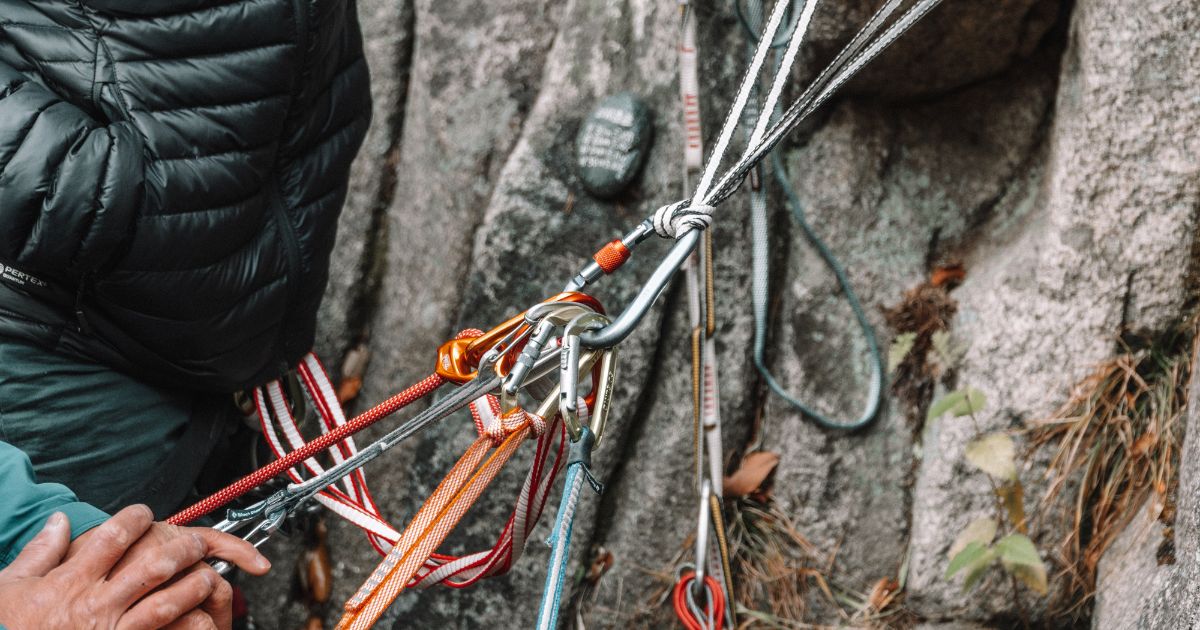Table of Contents
Choosing the right Carabiner: A Comprehensive Guide for Every Situation
We’ll explore the complex world of carabiners, an essential tool for tree climbers, in today’s talk. There are a wide variety of carabiner types available, so we’ll go over the fundamentals, ANSI standards, and useful advice to help novice and expert climbers make the best decisions.
We’ll go over the various kinds of carabiners in this guide, including locking, non-locking, and specialty carabiners, as well as their benefits and uses.
To preserve the longevity and safety of your carabiners, we’ll also offer maintenance and care guidelines. Whether you’re an amateur tree climber or a professional arborist, this thorough guide will give you the knowledge you need to select the ideal carabiner in every circumstance.
Understanding ANSI Standards
It’s important to comprehend the ANSI standards governing the use of carabiners in work positioning harnesses before getting into the specifics. According to ANSI standards, carabiners used in these kinds of applications need to be self-double locking, rated for a minimum of 23 kilonewtons, and able to withstand a force of up to 22.5 kilonewtons, or roughly 5400 pounds. This guarantees maximum safety, particularly in dire circumstances.
To guarantee ongoing safety and dependability, ANSI standards also mandate that carabiners used in work positioning harnesses go through routine maintenance and inspections.
Types of Carabiners
1. Classic Carabiner
The bullnose design of the classic carabiner, best represented by the Camp model, facilitates simple rope handling. However, because it adheres to ANSI standards, it’s more of an accessory.
The classic carabiner is a popular option for outdoor activities such as recreational climbing because of its sturdy construction and lightweight design. Its straightforward but sturdy construction enables fast and safe attachment to gear loops, ropes, and harnesses. It might not, however, adhere to the essential safety standards for use in an industrial or professional setting.
2. Triple-Locking Carabiners
Triple-locking carabiners, such as the DMM Perfecto, offer an extra degree of security because they require three steps to open. This lowers the possibility of inadvertent releases, which is important for work positioning harnesses.
Triple-locking carabiners are intended for use in hazardous environments where security is of utmost importance. When operating in hazardous or high-altitude conditions, users can rest easy knowing that the three-step opening motion offers an additional layer of security.
3. Steel Carabiners
Steel carabiners provide extra strength and weight, like the DMM double locker. Perfect for specific uses where the extra weight is useful, such as double-drop systems.
Because of their extraordinary strength and durability, steel carabiners, such as the DMM double locker, are ideal for specialized uses. In situations where robustness and reliability are critical, like double-drop systems, their additional weight can be beneficial.
These steel carabiners are an invaluable tool for professionals in a variety of fields because they provide a level of security and peace of mind that is essential in high-stakes situations.
4. Oval and Pear-shaped Carabiners
Carabiners in two common shapes are oval and pear. The oval shape ensures symmetrical loading, while the pear shape has advantages in hitch setups and pulley usage.
Carabiners in the shape of an oval or a pear are indispensable equipment for outdoor enthusiasts and climbers. Because of its symmetrical loading advantage, the oval design is a flexible choice for a range of applications.
Pear-shaped carabiners, on the other hand, work well with hitch configurations and pulley usage, providing particular benefits in some situations. Both varieties of carabiners are excellent additions to any gear collection, and each has special advantages of its own.
5. ANSI Gate-Rated Carabiners
Limited side loading scenarios are possible with carabiners with ANSI gate ratings, like the 27-kilonewton D-shaped model, because they offer greater strength. These are appropriate in situations where asymmetric loading could happen.
They are often employed in industrial and rescue settings where maintaining worker safety is of utmost importance. Carabiners with an ANSI gate rating go through extensive testing to make sure they adhere to strict durability and strength requirements. To protect yourself and other people, it’s critical to always use the right carabiner for the job.
6. Specialty Carabiners
Stainless steel inserts for increased durability and eye capture are two distinctive features of specialty carabiners, such as the Edelrid model. For increased safety, these are frequently worth the additional cost.
Certain specialty carabiners, like those made for ice climbing or rescue operations, may feature one-handed locking mechanisms or be made especially for use in those situations.
Additionally, these carabiners might be designed differently or have weight ratings or shapes that make them better suited for particular kinds of ropes or anchors. In the end, specialty carabiners can offer extra security and guarantee that you have the appropriate tools for the task at hand.
7. Snap Carabiners
Snap carabiners, such as those made by Notch and ISC, are useful for lanyards and speed lining, among other things. They meet specific needs with their design and locking mechanisms.
Because of their strength and longevity, snap carabiners are a dependable option for outdoor pursuits like rock climbing and tree maintenance. Both experts and enthusiasts favor them because of their lightweight design and user-friendly features. Snap carabiners are an adaptable tool for any task, whether you’re securing equipment or making a lifeline.
8. Screw-Gate Carabiners
When fastened correctly, screw-gate carabiners, which are frequently used in rock climbing, offer security. They might not meet ANSI requirements for some applications, though, and they do not have auto-double-locking capabilities.
In the climbing community, screw-gate carabiners are still commonly used, but users should be mindful of their limitations and make sure they are always securely fastened before using them.
Practical Considerations and Tips
1. Maintenance
Carabiners require regular maintenance because wear and sticking problems can occur. Carabiners should be kept lubricated, clean, and inspected frequently to guarantee maximum performance.
Using the appropriate carabiner for the job is crucial because they are made for different purposes. Always follow the manufacturer’s instructions and only use carabiners for the purposes for which they are designed. Never use a carabiner that has been dropped or damaged, and steer clear of cross-loading.
2. Storage
Carabiner storage must also be done properly. A dry, cool place is best for them; keep them out of direct sunlight and from extremely hot or cold temperatures. Make sure to store them so they don’t rub against other hard objects or each other.
3. Replacement
Carabiners eventually wear out and need to be replaced, even with proper maintenance. Make sure you replace your carabiners as needed by keeping track of their age and usage. Retiring a carabiner that exhibits wear or damage should not be delayed.
4. Training
Lastly, appropriate training is necessary for using carabiners safely and efficiently. Before applying them in a practical setting, make sure you have the right training and experience. Make sure you are using carabiners safely and effectively by keeping up with industry standards and best practices.
5. Avoiding Side Loading
Side-loading carabiners should be done with caution, as it may damage them. Select carabiners whose designs reduce the possibility of unintentional side loading.
The carabiner may cross-load due to side loading and fail when under load. To lower the possibility of side loading, look for carabiners with features like a wide basket or a keylock nose.
Before each use, check your carabiners to make sure they are in good shape and free of any damage that might weaken them.
6. Specialty Use Cases
Think about the unique requirements of your climbing assignments. For instance, choose ANSI gate-rated models for situations where limited side loading may occur and use steel carabiners for heavy-duty pulling with machinery.
7. Snap Carabiners for Speed Lining
Snap carabiners are essential for speed lining because they provide a quick and safe connection. But be aware of their deterioration and the possibility that they could shatter from shock loads.
Strength and durability should be given top priority when choosing snap carabiners for speed lining. Keep an eye out for wear and tear on them regularly, and replace them immediately if there are any doubts about their integrity.
In summary
Selecting the appropriate carabiner necessitates an awareness of design subtleties, standard compliance, and pragmatic factors. Climbers can choose carabiners that prioritize efficiency and safety by taking into account variables like material, locking mechanisms, and application-specific needs. A safe and successful ascent depends on making an informed choice when selecting carabiners, regardless of experience level.
Related Posts
- 5 Best Ways To Advance Quicker As A Boulderer
- How To Improve Your Climbing Footwork? – 4 key Stages
- Best Upper Body Workout for Climbers
- 7 Techniques Every Climber Must Know
- Breaking Conventional Rules in Climbing
- 7 Biggest Climbing Mistakes And How To Fix Them
- 8 Essential Tips for Outdoor Rock Climbing Beginners
- 70 Beginner Climbing Tips: The Most Important Techniques & Skills










Discussion about this post